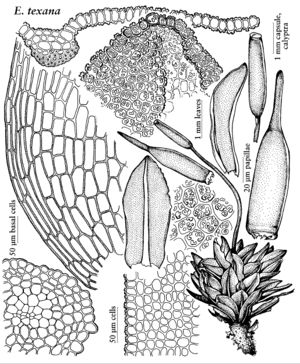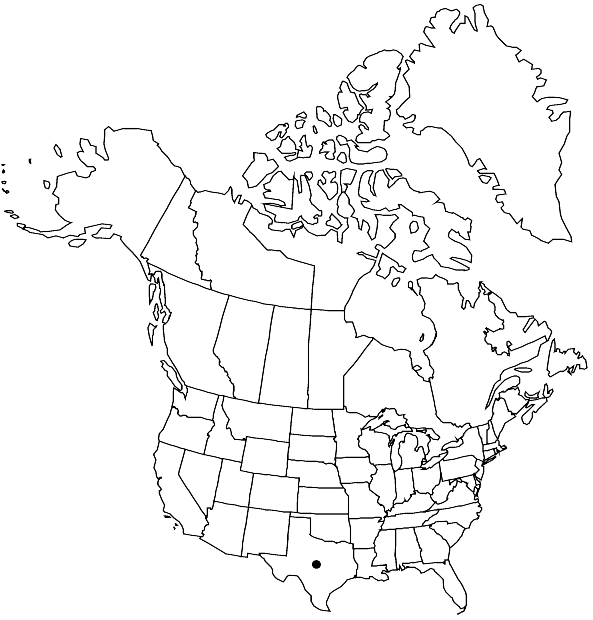Difference between revisions of "Encalypta texana"
Bryologist 109: 399, figs. 1–11. 2006,.
FNA>Volume Importer |
imported>Volume Importer |
||
| (6 intermediate revisions by 2 users not shown) | |||
| Line 20: | Line 20: | ||
|habitat=Igneous soil in rock crevices | |habitat=Igneous soil in rock crevices | ||
|distribution=Tex. | |distribution=Tex. | ||
| − | |discussion=<p>Encalypta texana was previously identified as a North American specimen of E. sibirica (Weinmann) Warnstorf. Several distinct characters and important habitat and distributional factors, however, set it apart from that Asian species: costa ending just before the apex, capsule length, calyptra ornamentation, spore ornamentation, and differences in gametophyte and calyptra color. Encalypta texana could be confused with another species with gymnostomous capsules and costae ending before the leaf apex, E. flowersiana, which is also present in the mountains of western Texas. Encalypta flowersiana is smaller, with leaf margins plane, capsule furrowed, and spores have distinct ridges, while E. texana has laminal margins incurved to plane distally and recurved proximally, capsule smooth to weakly wrinkled, and spores finely pitted.</p> | + | |discussion=<p><i>Encalypta texana</i> was previously identified as a North American specimen of <i>E. sibirica</i> (Weinmann) Warnstorf. Several distinct characters and important habitat and distributional factors, however, set it apart from that Asian species: costa ending just before the apex, capsule length, calyptra ornamentation, spore ornamentation, and differences in gametophyte and calyptra color. <i>Encalypta texana</i> could be confused with another species with gymnostomous capsules and costae ending before the leaf apex, <i>E. flowersiana</i>, which is also present in the mountains of western Texas. <i>Encalypta flowersiana</i> is smaller, with leaf margins plane, capsule furrowed, and spores have distinct ridges, while <i>E. texana</i> has laminal margins incurved to plane distally and recurved proximally, capsule smooth to weakly wrinkled, and spores finely pitted.</p> |
|tables= | |tables= | ||
|references= | |references= | ||
| Line 29: | Line 29: | ||
-->{{#Taxon: | -->{{#Taxon: | ||
name=Encalypta texana | name=Encalypta texana | ||
| − | |||
|authority=Magill | |authority=Magill | ||
|rank=species | |rank=species | ||
| Line 42: | Line 41: | ||
|publication year= | |publication year= | ||
|special status= | |special status= | ||
| − | |source xml=https:// | + | |source xml=https://bitbucket.org/aafc-mbb/fna-data-curation/src/2e0870ddd59836b60bcf96646a41e87ea5a5943a/coarse_grained_fna_xml/V27/V27_223.xml |
|genus=Encalypta | |genus=Encalypta | ||
|species=Encalypta texana | |species=Encalypta texana | ||
Latest revision as of 21:25, 5 November 2020
Stems 5–10 mm, central strand small. Leaves broadly oblong to elliptic, 3–4 mm; apices broadly acute, mucronate; margins plane to erect or incurved distally or weakly recurved proximally; costa percurrent to subpercurrect, narrow, papillose distally on adaxial surface; laminal cells 15–25 µm; basal cells 25–75 µm, walls thickened, smooth; basal marginal cells weakly differentiated, longer than laminal cells, in 3–5 rows. Specialized asexual reproduction absent. Seta 4–6 mm, yellow-brown. Capsule cylindric, 1.8–2 mm, smooth to weakly wrinkled when dry, gymnostomous, yellowish brown; exothecial cells quadrate, walls thickened; peristome absent; operculum 0.5 mm. Calyptra 3–4 mm, irregularly fringed at base, weakly papillose to essentially smooth. Spores 30–35 µm, finely pitted, reddish brown.
Habitat: Igneous soil in rock crevices
Discussion
Encalypta texana was previously identified as a North American specimen of E. sibirica (Weinmann) Warnstorf. Several distinct characters and important habitat and distributional factors, however, set it apart from that Asian species: costa ending just before the apex, capsule length, calyptra ornamentation, spore ornamentation, and differences in gametophyte and calyptra color. Encalypta texana could be confused with another species with gymnostomous capsules and costae ending before the leaf apex, E. flowersiana, which is also present in the mountains of western Texas. Encalypta flowersiana is smaller, with leaf margins plane, capsule furrowed, and spores have distinct ridges, while E. texana has laminal margins incurved to plane distally and recurved proximally, capsule smooth to weakly wrinkled, and spores finely pitted.
Selected References
None.

